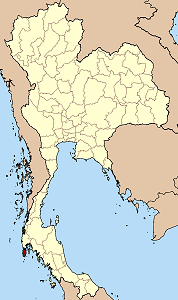Phuket Province
|
|
| Statistics | |
|---|---|
| Capital: | Phuket city |
| Area: | 543.0 km² Ranked 75th |
| Inhabitants: | 287,587 (2004) Ranked 68th |
| Pop. density: | 529.63 inh./km² Ranked 6th |
| ISO 3166-2: | TH-83 |
| Map | |

| |
Phuket (Thai ภูเก็ต) (formerly known as Tha-Laang or Talang) is one of the southern provinces (changwat) of Thailand. Neighbouring provinces are (from north clockwise) Phang Nga and Krabi, but as Phuket is an island there are no land boundaries. The island is served by Phuket International Airport, located in the north of the island. The ph of "Phuket" is an aspirated hard "p", not a soft "f", so the name is pronounced (roughly) "Pew-get". The name Phuket itself means the Cape of "Tin", which has been used since tin mining became popular. Before that its old name was Ta-lang (in Thai), which is still in used for one of the main provinces in the Phuket area.
| Contents |
Geography
Phuket is the biggest island in Thailand, located in the Andaman Sea, southern part of Thailand. The island is mostly mountainous with a mountain range in the west of the island from the north to the south. The mountains of Phuket form the southern end of a mountain chain, which ranges for 440 km from the Kra Isthmus. The highest elevation of the whole Phuket chain is the Khao Phra Mi with an elevation of 1138 m, however the highest elevation on the island itself is Mai Tha Sip Song (Twelve Canes), at 529 m above sea level.
70% of the island is covered by forest. The western coast has several sandy beaches, while on the east coast are more muddy beaches. Nearly the southernmost point is Laem Promthep, which is a popular sunset viewpoint.
The main tourist region in Phuket is Patong Beach, which also contains most of Phuket's nightlife and is the centre of cheap shopping on the island. Patong means "the forest fulled of Banana leaves" in Thai. Other popular beaches include Karon Beach, Kata Beach, Kata Noi Beach, Nai Harn Beach and Bang Tao Beach.
Economy
Tin mining has been a major source of income for the island since the 16th century. Many Chinese workers were employed in the mines, and their influence on Phuket culture can still be felt today. With falling tin prices, the mining has now all but ceased. Nowadays, Phuket's economy rests on two pillars: rubber tree plantations (making Thailand the biggest producer of rubber in the world) and tourism.
Since the 1980s Phuket has become one of the major tourist attractions of Thailand, and most of the sandy beaches on the western coast of the island have been developed into tourist centers, with Patong, Karon and Kata being the most popular ones.
History
The most significant event in the history of Phuket was the attack by the Burmese in 1785 after king Taksin had fought them back. Sir Francis Light, a British East India Company captain passing the island, sent word to the local administration that Burmese forces were preparing for an attack. Kunying Jan, the wife of the recently deceased governor, and her sister Mook then assembled forces. After one month of siege the Burmese had to turn back on March 13, 1785, and the two women became local heroines, receiving the honorary names Thao Thep Kasatri and Thao Sri Sunthon from King Rama I.
During the reign of King Chulalongkorn (Rama V) Phuket became the administrative center of the tin-producing southern provinces. In 1933 the Monthon Phuket was dissolved and Phuket became a province by itself.
Old names of the island include Ko Thalang, and Junk Ceylon, an English corruption of the Malay Tanjung Salang (Cape Salang).
Phuket and other areas of Thailand's west coast suffered extensive damage during the 2004 Indian Ocean earthquake and the resulting tsunami that struck on December 26, destroying some tourist sites in the region and killing as many as 5,300 people nationwide. There were reports of as many as 250 or more dead in Phuket, including some foreign tourists. The tsunami was caused by a giant earthquake off the coast of Sumatra, Indonesia, and also killed thousands in other parts of Asia as well. Relief efforts in the area were still ongoing as of the end of 2004.
Demographics
As with most of Thailand, the majority of the population is Buddhist, but there are a significant number of Muslims (5%) in Phuket, mostly descendants of the island's original sea-sided people population..
Symbols
| Missing image Seal_Phuket.png Provincial seal | The provincial seal shows the two heroines of the province, Thao Thep Kasattri and Thao Sri Sunthon.
The provincial tree is the Burmese Rosewood (Pterocarpus indicus), and the provincial flower the Pepper Flower (Bougainvillea sp.). |
Administrative divisions
Amphoe_Phuket.png
Map of Amphoe
Phuket is divided into 3 districts (Amphoe), which are further subdivided into 17 communes (tambon) and 103 villages (mubaan).
- Mueang Phuket
- Kathu
- Thalang
External links
- Province page from the Tourist Authority of Thailand (http://www.tourismthailand.org/province/province.php?id=8)
- Golden Jubilee Network province guide (http://kanchanapisek.or.th/cgi-bin/kp8/oncc/province.cgi?prov=s9)
- Phuket Gazette (http://www.phuketgazette.net/) - news
de:Phuket (Provinz) fi:Phuket fr:Province de Phuket ms:Wilayah Phuket id:Phuket ja:プーケット県 nl:Changwat Phuket no:Phuket pl:Phuket pt:Ilhas Phuket th:จังหวัดภูเก็ต



